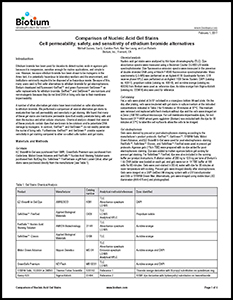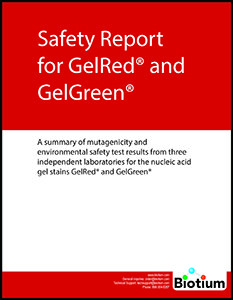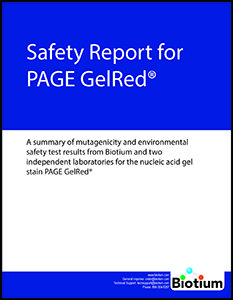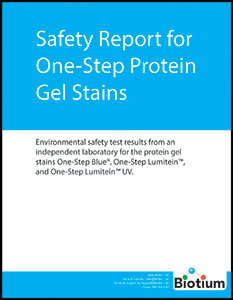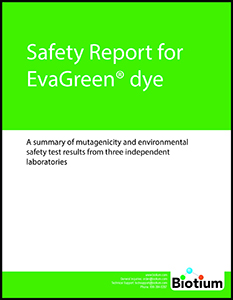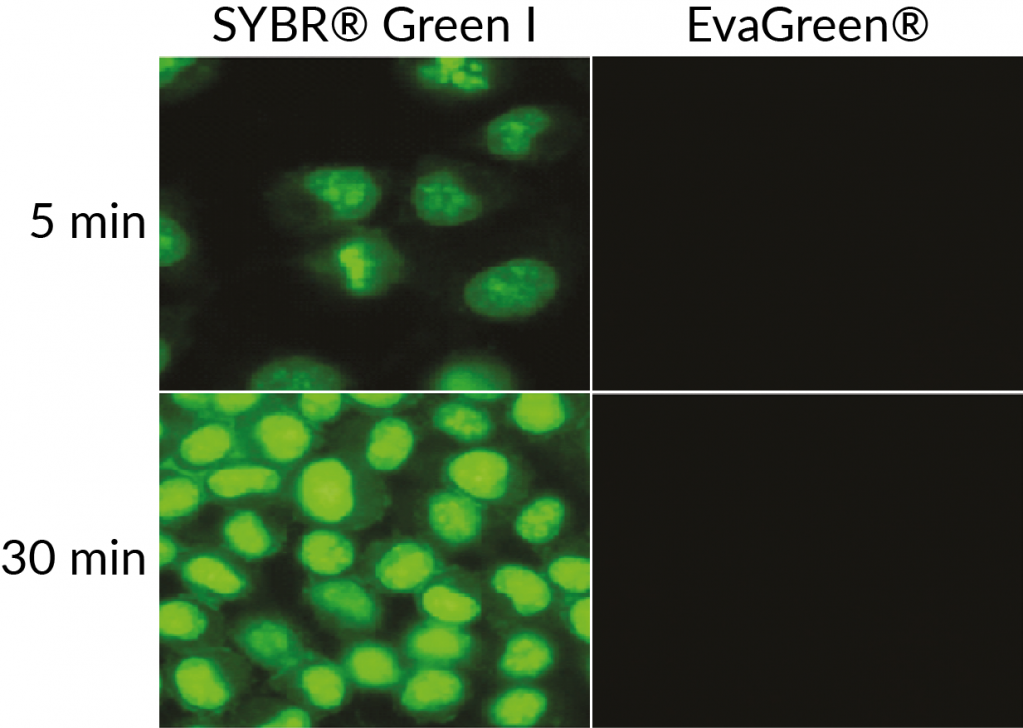Our Contribution to Sustainable Research
As a manufacturer and supplier of chemical reagents for research, we at Biotium understand the critical role we play in protecting the Earth’s natural resources. Consequently, our commitment to innovation not only entails pushing the boundaries of performance, but also how our products can contribute to a safer and more sustainable research environment.
For this reason, whenever possible we strive to develop products that can be disposed down the sink without harming wildlife. We also design our products with researchers’ safety in mind. And unlike other companies that claim their products are safe, we have data to back us up, including environmental safety reports from third party testing facilities. The dyes featured here are all classified as non-hazardous for waste disposal under California Title 22 regulations.
In addition, our primary manufacturing facility located in the San Francisco Bay Area is committed to minimizing its carbon footprint by implementing green methods to our systems and business practices. This includes maximizing biodegradable materials in our packaging and providing all product related documents electronically. Our facility also relies heavily on renewable energy by sourcing 80% of our power needs from solar energy.
Searching for Earth-Friendly Alternatives?
Look for this symbol
![]() For convenience, we have labeled certain product pages and product search results for customers looking for more sustainable alternatives. Products labeled with this symbol will have at least one of the following features.
For convenience, we have labeled certain product pages and product search results for customers looking for more sustainable alternatives. Products labeled with this symbol will have at least one of the following features.
- Non-toxic and less hazardous alternative
- Environmentally friendly disposal
- Greater efficiency for less waste of resources
DNA Gel Stains
GelRed® and GelGreen®
Safer alternatives to EtBr, SYBR® Safe, and others
GelRed® and GelGreen® are sensitive fluorescent DNA gel stains designed to replace highly toxic ethidium bromide (EtBr) and other so-called safe gel stains. Ames tests have confirmed that GelRed® and GelGreen® are non-mutagenic at concentrations well above the concentrations used for gel staining. Furthermore, environmental safety tests showed that GelRed® and GelGreen® are non-toxic to aquatic life, permitting disposal down the drain or in regular trash. To learn more, visit the GelRed® and GelGreen® technology page.
GelRed® and GelGreen® stains are also available pre-coated to ultra-pure LE agarose. Using GelRed® Agarose LE & GelGreen® Agarose LE is easy and convenient, and obviates the need to handle concentrated fluorescent dye.
PAGE GelRed® is a DNA gel stain for use in acrylamide gels. In designing PAGE GelRed® dye, we used a novel approach to make the dye membrane-impermeant without significantly increasing its size. Like the regular GelRed® and GelGreen®, it does not penetrate into cells, unlike other supposedly safe dyes.
See our safety data reports for our GelRed® and GelGreen® products below.

Protein Gel Stains
One-Step protein gel stains are ready-to-use solutions for the staining of PAGE gels. They produce fast protein staining in a single step without fixation or washing. In addition to rapid results and simple staining, One-Step stains offer safer handling and disposal compared to Coomassie and other stains because they are entirely aqueous-based, without hazardous methanol or acetic acid.
Biotium offers several versions of One-Step stains for different visualization methods. One-Step Blue® can be detected by visible blue staining or by near-infrared fluorescence. One-Step Lumitein™ is a red fluorescent protein gel stain that is able to be detected using a UV light box, laser gel scanner or blue light illuminator like Gel-Bright™. One-Step Lumitein™ UV is optimized for maximum sensitivity on a UV transilluminator. See our safety data report for our One-Step products on the right. To learn more please visit our One-Step protein gel stains technology page.
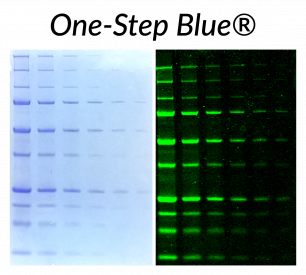

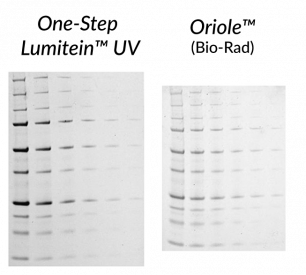
EvaGreen® qPCR Master Mixes
EvaGreen® Dye is the first and only PCR dye to date designed to be environmentally safe.
Handling and disposal of DNA-binding dyes in PCR master mixes can be a health and environmental issue due to their ability to cause mutations. Indeed, SYBR® Green I is found to be even more environmentally toxic than ethidium bromide, one of the best known mutagens. SYBR® Green I has been suggested to interfere with DNA repair mechanisms in cells, and as a result it potentiates genotoxicity of chemicals as well as DNA damage by UV light.
Although no safety data are available on other PCR and HRM dyes (e.g., SYTO9, LC Green, BRYT Green and ResoLight), those dyes are all known to enter cells in a matter of minutes, thus posing potential genotoxicity risk. With this in mind, Biotium’s scientists designed EvaGreen® Dye to be cell membrane-impermeant by increasing the molecular size and charge of the dye. Because EvaGreen® Dye is denied the chance to interact with genomic DNA in living cells, it is made much safer than the other dyes. Independent laboratory tests have confirmed that EvaGreen® is non-mutagenic, non-cytotoxic and safe to aquatic life. The dye has passed environmental hazardous waste regulation in the state of California (CCR title 22) for easy disposal down the drain. To learn more please visit our EvaGreen® Dye technology page.
Learn more about our Forget-Me-Not™ qPCR Master Mixes which are hot-start EvaGreen® dye-based master mixes for use in real time PCR applications and DNA melt curve analysis. They are available in no, low or high ROX formulations. There are also options available for two-color tracking, to reduce pipetting errors.
See our safety data report for EvaGreen® Dye below.
DNA Quantitation Kits
Biotium offers a wide selection of fluorescence-based DNA quantitation kits that vary in concentration range, instrument compatibility, and detection channel. Our AccuBlue® High Sensitivity dsDNA Quantitation Kit for microplate readers uses non-toxic and non-mutagenic EvaGreen® Dye for safer handling and easy disposal. Similarly, our AccuGreen™ Broad Range dsDNA Quantitation Kit designed for Thermo’s Qubit® fluorometer also uses a non-toxic and non-mutagenic DNA-binding dye. Learn more about our complete line of kits on our DNA & RNA quantitation technology page.
AccuBlue® High Sensitivity dsDNA Quantitation Kit
- Highly specific for dsDNA
- Uses a non-toxic, non-mutagenic EvaGreen® Dye
- Linear detection range from 0.2-100 ng dsDNA
- Designed for fluorescence microplate readers
- Green fluorescence emission
AccuGreen™ Broad Range dsDNA Quantitation Kit
- Designed specifically for Thermo’s Qubit® fluorometer
- Uses a non-toxic, non-mutagenic dye
- Linear detection range from 2-1000 ng dsDNA
- Replaces Qubit® dsDNA BR Assay Kit for cost savings
- Green fluorescence emission
Complete List of Earth-Friendly Products
| Product Name | Catalog Number | Application | Safety Features |
|---|---|---|---|
| GelRed® 10,000X in water | 41001-41003 | DNA Gel Stains | Safer, non-mutagenic, and non-toxic alternatives to EtBr Designed to be cell membrane impermeant Certified under CCR Title 22 as non-toxic. Suitable for non-hazardous disposal |
| GelGreen® 10,000X in water | 41004-41005 | ||
| GelRed® 3X in water | 41001 | ||
| 6X GelRed® Prestain Loading Buffer, Blue Tracking Dye | 41009-41010 | ||
| GelRed® Prestain Plus 6X DNA Loading Dye | 41011 | ||
| GelRed® Agarose LE | 41029 | ||
| GelGreen® Agarose LE | 41030 | ||
|
One-Step Blue® |
21003 | Protein Gel Stains | 100% Water-based formulation No need for acetic acid, methanol, microwaving, washing or fixing Certified under CCR Title 22 as non-toxic Suitable for drain disposal after a simple pH neutralization step |
| One-Step Lumitein™ | 21004 | ||
| One-Step Lumitein™ UV | 21005 | ||
| EvaGreen® Dye, 20X in Water | 31000 | DNA Binding Dye for qPCR | Environmentally safe, non-mutagenic, and non-cytotoxic |
| EvaGreen® Dye, 2000X in DMSO | 31019 | ||
| EvaGreen® Plus Dye, 20X in Water | 31077 | ||
| Forget-Me-Not™ EvaGreen® qPCR Master Mix (2-Color Tracking) | 31041-31042 | qPCR Master Mixes | Includes environmentally safe, non-mutagenic, and non-cytotoxic EvaGreen® Dye |
| Forget-Me-Not™ EvaGreen® qPCR Master Mix (Premixed Low ROX or High ROX) | 31045-31046 | ||
| AccuBlue® High Sensitivity dsDNA Quantitation Kit with Standards | 31006 | DNA Quantitation | Non-toxic and non-mutagenic DNA-binding dyes |
| AccuGreen™ Broad Range dsDNA Quantitation Kit | 31069 | ||
| AccuGreen™ Broad Range dsDNA Quantitation Solution | 31070 | ||
| EvaEZ™ Fluorometric Polymerase Activity Assay Kit | 29051 | Polymerase Activity Assay | Fluorescence based assay kit for measuring activity of nucleic acid polymerase without using radioisotopes |
| CoverGrip™ Coverslip Sealant | 23005 | Coverslip sealant | Coverslip sealant made with d-limonene, a natural, environmentally-friendly alternative to nail-polish |



